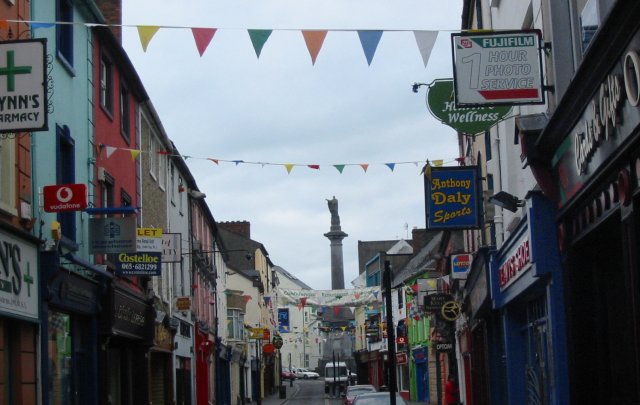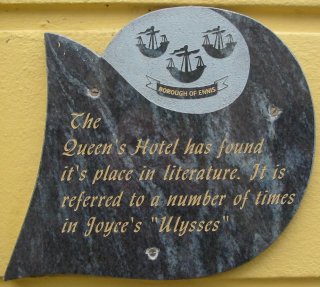 |
22. A homage to Joyce in Ennis |
|||
|
'May the wind be always at your back.' So goes the cyclists' blessing or invocation. But it is said more in a spirit of irony than hope, because the wind always seems to find a way of turning against you. All week we had seen forecasts of foul weather rolling in from the south-west. But either it rolled through while we slept, or not at all, because all our days had been fine and mostly sunny. On the day of our ride from Kilkee to Ennis it caught us. As we looked at the rain while we breakfasted, we consoled ourselves with the thought that at least the wind would be driving the rain into our backs. But we cycled out into a north-easter that battered the rain into our faces all day and had me struggling up the slightest incline (of which there were more than a few, and not so slight either). The wind almost fought me to a standstill. Partly in a spirit of adventure, and partly due to a poor pre-ride briefing, we cycled out of Kilkee on the Kilrush road, which was not the plan. We regathered (which entailed some retracing of revolutions) at the junction before Lisdeen P.O., and made our way north to the N67 near Farrihy. Our way then was through Doonbeg, leaving the N67 on the R484 to Creegh (on the map, but Cree on signposts), from which minor roads lead in an almost direct line to Ennis. At Cree one signpost read 'Ennis 34Km'. But at the next junction down this road we read: 'Cree 4½; Ennis 22'. That had to be in miles, but made the distance from Cree to Ennis 42Km. This was not our first confusion with distances on signposts which might have been in miles or kilometres but failed to agree in either. Marie had a professional interest (not a gambling one) in a horse race at 2.20 that day. She just managed to reach the Paddy Power shop in Abbey Street in time to see it. We stood outside holding bikes and dripping. We are very grateful to Ella at Ardlee House, Clare Road, Ennis, who took in four wet and bedraggled cyclists (Eu.30) and dried all their sopping kit for them. |
 |
Later, on what turned out a fine, dry evening (as far as weather was concerned), we wandered about the town, and ate in Grogan's, where a la carte sirloin is Eu.17.95 and a 10oz. fillet 22.95, which compares very unfavourably to the West End in Fenit on three counts: quality, size, and price. But the food was reasonable and served with a smile, unless you ate off the bar menu, when it was thrown on a plate and over-heated in a microwave. This was the last day of Ennis's Irish music festival. There was live music advertised to begin in Grogan's at 9.00 p.m. As we left shortly after 10 we saw a man with a case that might have contained a guitar, but once again the attractions of an early night were stronger. |
 |
|
O'Connell Street, Ennis, and the man himself on his pillar. |
|
|
|
 |
|
The tower of Ennis Friary and, in front of it, the Queen's Hotel. |
|

|
 |
The plaque on the Queen's Hotel records its connection with Joyce's Ulysses with great reticence. It actually owes its place in the book (a work of fiction) to the death there of Rudolf Bloom (Rudolf Virag) on the evening of the 27th June 1886,' in consequence of an overdose of monkshood (aconite) selfadministered in the form of a neuralgic liniment ...' I suppose a suicide on the premises, even a fictional one, is not what you want to put on a plaque by the front door of your hotel. |
|
I first read Ulysses in 1960, borrowing it from the library on the south side of the River Lagan in Ormeau Road, Belfast, where the librarian had to go and fetch it from a back room. The story is about real and fictitious events, mostly in Dublin, on one day, 16th June 1904. The 16th June is now known as 'Bloomsday' by fans of the book and Irish tourism promoters. And this year is the centenary, the excuse for all sorts of events in Dublin. I paid my own homage to Ulysses by seeking out the Queen's Hotel in Ennis. |
|
 |
22. A homage to Joyce in Ennis |
|||
|




